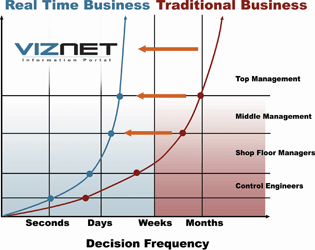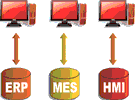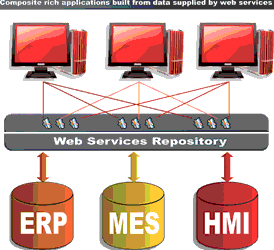
“Services oriented architecture (SOA) is being positioned as the next big thing in system information and communications. SOA is presently enjoying similar hype to that which surrounded any number of other cure-all solutions, such as CRM, business intelligence and countless other technologies or concepts that were perceived as the answer to technology problems,” says Adroit Technologies’ managing director Dave Wibberly.
Introduction
As with many new technological fashions, SOA promises to deliver better, faster, cheaper IT support than was possible before its arrival. However, all this hype seems to have resulted in a great deal of confusion around just what SOA is, and what it is not. In this article we take a look at SOA and the how the realtime enterprise is driving the migration to SOA.
The realtime enterprise
It is important to try and understand the concept of the realtime enterprise. For instrumentation and control engineers the realtime world is in seconds or better. To a production manager the concept of realtime on say a batching plant may be at best the duration of the batch, production run or shift. To an operations manager dealing with a number of lines in a factory, realtime is probably moved back to a daily basis. The financial director is probably used to making decisions on a monthly or at best weekly basis given the accounting cycle.

Fundamental to the idea of the realtime enterprise is making data from all systems available for exposing key performance indicators (KPIs), compressing and reducing reporting cycles, and defining metrics for decision makers across an organisation with a view to exposing problems earlier. This in turn will lead to improved operational efficiency through quicker corrective actions and decisions.
How has technology evolved to support this concept?
OPC
In the instrumentation and control world OPC (OLE for process control) made its way onto the scene in the late '90s as a way of allowing interoperability between systems. OPC was developed as a standard way of exposing and accessing data between different software products. However, it was designed with process control markets' needs in mind for exposing single pieces of realtime data in a defined way and allowing different applications to inter-operate and exchange data reliably and seamlessly.
Web services
Web services were introduced as a way of similarly allowing systems to expose data in a loosely coupled, object oriented way. The technology offers a standard way for an application to interface to and consume the service or data from another application.
The concept of Web services was born out of Web-based applications enabling others that want to use the service supplied without having to either embed code or tightly bind themselves to that provider of information.
An example of this would be a South African-based company that supplies, say, an advanced control algorithm in the form of a software application. Due to the complex nature of such software the company would be fairly limited in the geographical area in which it could offer its software.
The traditional way for a client to implement the advanced control offered would be to purchase the software, install it on site, get trained and use the product. New versions of the algorithm would necessitate upgrading the software on site - probably at great cost.
Using Web services approach it would be possible for the supplier to expose their advanced control algorithm service to the entire world. The supplier would host the main application at their offices, and write code to expose the variables needed to run the algorithm via a Web service. Any client could then employ the software through very simple code. The client code would periodically connect to the Web service and pass the necessary variables from the plant to the algorithm. The Web service would then perform the necessary advanced control algorithm and return new process setpoints to the client.
The advantage of this approach is that the client does not need to update his own site software as improvements are made to the algorithm. It is only the vendor that upgrades and optimises the code accessed by the Web service.
With Web services, users are generally not concerned about what versions are being used, as long as the software works. All users need is an Internet connection. If the algorithm does not work to the client's satisfaction, the client is not locked-in and can simply go to another vendor of a similar service, irrespective of geographical location of vendor and of client.
The advantage is that anyone, anywhere in the world can now use these services. Whether the commercial model is pay-per-use or subscription based, many maintenance headaches are removed.
Migrating to SOA
SOA extends the two basic principles of the above example (software as a service and Web services) into a defined IT architecture. The technology offers a way of structuring software components in a standardised way to obtain additional benefits without necessarily providing anything unique or additional.
Talking about the migration to SOA, Dave Wibberley, managing director of Adroit Technologies, says: "Organisations start with an application silo architecture, which is mostly individual applications. They then move through standardised architecture involving more standardisation and centralisation. At that point they have a rationalised data architecture that includes the standardisation of data and processes with a view to ultimately achieving a services oriented architecture."

Having all the necessary applications used within an organisation implement Web service interfaces and using product offerings such as .Net visualisation platform, Viznet, and TIBCO (integration server software for enterprises), users can create an SOA layer that facilitates the development of the business tools and management dashboards required to support realtime enterprises.
"People need to realise that SOA will not magically solve integration issues or suddenly allow companies to re-use components of software, there are numerous underlying design decisions and imperatives that have to first be considered," says Wibberley. "The general feeling amongst IT practitioners is that although the return on investment (ROI) is difficult to quantify, companies that implement SOA will generally see the returns after the second or third project."

Adroit Technologies' technical director Mike Lamusse points out, "We have already implemented a Web service interface to Adroit and Viznet. It is architected on an SOA approach so as vendors we are SOA ready."
"Viznet product is well-suited to building a composite portal around a company's SOA because it can auto-discover Web services and integrates into other disparate and legacy systems through standards such as OLEDB (Object Linking and Embedding Database) and OPC making it a very complementary application," concludes Lamusse.
For more information contact Dave Wibberley, Adroit Technologies, +27 (0)11 658 8100, [email protected], www.adroit.co.za
| Tel: | +27 11 658 8100 |
| Email: | [email protected] |
| www: | www.adroitscada.com |
| Articles: | More information and articles about Adroit Technologies |

© Technews Publishing (Pty) Ltd | All Rights Reserved